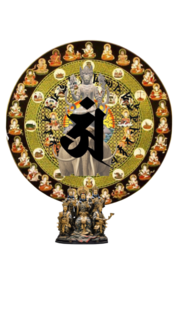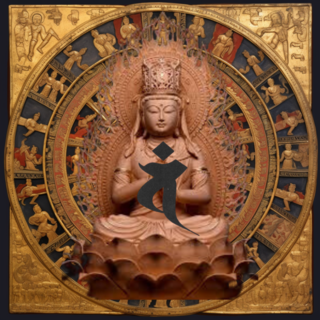如是我聞と「阿含経」
如是我聞。一時仏住迦毘羅衛国尼拘 律園中。爾時釈氏摩訶男来詣仏所。 稽首仏足退坐一面。 白仏言。世尊。 何名優婆塞。仏告摩訶男。 優婆塞 在家清白。乃至尽寿帰依三宝為優 婆塞証知我。
- 現代語訳
- 一切
是の如く現れ聞きぬ。一時、仏、逆毘羅衛国狗律園
中に住まりたまえり。雨の時釈 氏摩訶男、仏の所に来 し、私の足にしたてまつり退いて一面に坐し、仏 に白してさく、「世尊よ、何が優婆塞と名づくるや」と仏、摩訶男に告げたまわく、「優婆塞とは在家清白乃至「寿尽くるまで三宝に帰依し、優婆塞と為らん 我れを証知したまえ』」 と。
このように私は聞きました。ある時、仏さまがカピラヴァットゥ (迦毘羅衛国)のニグローダ (拘律)園におとどまりになっておられました。そこへ、在家の弟子であり、仏さまの従兄弟 でもあるマハーナーマ (摩訶男)が、数人の在家信者を引き連れて現われ、仏足頂礼の礼をして 仏さまの前に座り、質問いたしました。
「世尊よ、優婆塞 (在家仏教徒) とは、どのような人に対して名づけられたものでありましょう
仏さまはマハーナーマに、
「在家の者が仏や師となる僧侶のもとに行き、「自分が生きているかぎり、死ぬまでの今後一生 を通して三宝に帰依いたします。 私を優婆塞としてお認めください」と申し出て、仏や僧侶がそ れを認めるならば、その者は優婆塞となります」
と告げられました。
解説
まず、最初に「姫是我(是の如く我れ聞きぬ)」という言葉があります。ほとんどのお経がこ の言葉で始まっておりますが、「私はこのように仏さまからうかがいました」という意味です。 この「私」とはだれか?
これは、お釈迦さまの十大弟子の一人で、記憶力第一といわれたアーナンダ(阿難であると されております。 アーナンダという方は、二十五年間にわたってお釈迦さまのおそば近くに仕え、 その説法の一言一句を残らず記憶していました。 お釈迦さまがお亡くなりになった直後、このア ナンダや大長老のマハーカッサパ(摩迦葉)を含めた五百人の仏弟子たちがラージャガハマハーカッサパが座長になり、アーナンダが自分の聞き覚えていたものを口述し、それを弟子たち全員で議論していくという形で、教法はまとめられていきました。
(王舎城)の七葉窟に集結し、お釈迦さまの教法の編纂を始めたわけです。
たとえばアーナンダが、
「私は祇園精舎でこのような教えを拝聴しました」
と話すと、それに異論のある者は手を挙げて、
「それは私の記憶とは違う・・・・・・」
と自分の記憶している内容を述べたわけです。すると座長のマハーカッサパが、
「みなさんはどのように記憶しておられますか?」
と、他の弟子たちに語り、それぞれが記憶をたどりながら、正しい答えを導き出してまとめて いったわけです(『南伝律」「小品」 十一秒)。そのようにして編纂されていった経典が「阿含経」 です。ですから、「阿含経」に「如是我聞」という言葉が使われているのは当然です。 ところが、仏 滅後数百年経ってから創作された経典、たとえば『法華経』や『華厳経』などの大乗経典も、 「阿含経」の形式をまねて「如是我聞」の四文字から始まっています。 これは言語道断です。 ほ とんどの経典がこの「如是我聞」から始まるために、後世の人たちはすべてのお経はお釈迦さま 一代の教説である、と思い込んでしまったのです。さらには、間違った教相判釈が立てられ、 「阿含経」は小乗経典という、まったく見当違いの評価を受けるようになってしまいました。
「如是我聞」 はたった四文字の言葉ですが、これほど重要な意味を持っています。わたくしたち は、「如是我聞」 を使うことのできるお経は「阿含経」だけなのだという真実をよく理解すると 共に、それを世間に広めていかなければなりません。
優婆塞とはなにか
それでは、お経の内容を解説いたしましょう。
ある時、お釈迦さまがカピラヴァットゥ (迦羅衛国)のニグローダ(尼拘律)園におられまし た。カピラヴァットゥというのはお釈迦さまの故郷で、現在のネパールのタライ地方付近である といわれております。そのカピラヴァットゥにニグローダ(サンスクリット語ではニヤグローダ。 バニヤンの樹)という樹木がたくさん生えている林があり、その中の精舎、つまり道場にお釈迦 さまは滞在されておられました。
そこへ、在家の弟子であり、またお釈迦さまの従兄弟でもあるマハーナーマ(摩訶男)が、数 人の在家信者を引き連れて現われ、仏足頂礼の礼をしてお釈迦さまの前に座り、質問いたしまし
仏門に帰依した者はすべてお釈迦さまの子であるという考えから、仏教徒を釈子あるいは釈氏 といいます。しかし、ここに登場するマハーナーマはお釈迦さまと同じ釈迦族の人ですから、こ ここでいう釈氏は「仏教徒の」と訳すだけではなく、 「釈迦族の」と訳してもよいでしょう。
「仏の足に稽首したてまつり」とは仏足頂礼といい、五体を地につけてお釈迦さまのおみ足を 額にいただく礼拝のことです。インドではこれがいちばん丁寧で、心からの帰依を表す礼とされ ております。仏足頂礼は五体を地につけて礼拝するので、五体投地とも呼びます。 スリランカな どの南伝仏教の国では、パーリ語で「ブッダム サラナム ガッチャーミ(われ、仏に帰依したてまつる)」と唱えて仏足頂礼の礼をします。 わたくしたちは勤行の時に膝をかがめて、
オサラバタタギャタ ハンナマンナノウ キャロミ」
礼拝いたしますが、これは五体投地を簡略化したものです。
しかし、形の上では簡略化してありますが、心の中では五体を地につけてお釈迦さまのおみ足をいただいてる、と観想して礼拝しなければいけません。
と質問したわけです。
マハーナーマもこの時、仏足を頂礼してお釈迦さまにご挨拶し、
「世尊よ、優婆塞とは、どのような人に対して名づけられたものでありましょうか?」
優婆塞とはパーリ語・サンスクリット語のウバーサカを漢字に音写したもので、普通は男性の 在家信者を指します。 これに対して女性の在家信者は優婆夷と呼び、同じくパーリ語・サンスク リット語でウバーシカーといいます。
それでは、マハーナーマはそのようなことも知らなかったのか、というとそうではありません。 逆に、彼は優婆塞の深い意味をよく知った上で、質問しているのです。それは、なぜでしょう か?
マハーナーマ自身は優婆塞についてよく知っているけれども、自分が連れてきた者たちはまだ よく分かっていない。 そこで、優婆塞の心構えを知ってもらうために、わざと自分自身も知らな ふりをしてお釈迦さまに質問しているわけです。このような質問の仕方を赴機間と呼びます。 仏教経典の中には、時々こういう赴機間が出てきます。
Nyoze Gamon and Agon Sutra
Just ask me. Temporarily resides in the Kabira Ekokuni Prison. This is the Buddhist temple where Mr. Jishakuji Makoto visited. One side of the practice head Buddha foot retreat. White Buddhism. World Honored One. What a good old lady. Buddhist monk. Yubasai is a layperson. From life to devotion to the three treasures, the mother knows me.
modern language translation
nothing at all
He appears and does not hear. Temporary Buddha
Maeri lived inside. When it rains, Ujimakao comes to the Buddha, puts his feet on my feet, recedes, sits down on one side, and bows to the Buddha, saying, "World-Honored One, what is the name of Yubasa?" Buddha said to Makoto, ``A yubasai is a pure layman.
This is how I heard. Once upon a time, the Buddha was residing in the Nigroda Garden in Kapilavattu. There, a mahanama, a lay disciple and a cousin of the Buddha, appeared with several lay followers, and sat down in front of the Buddha, asking a question. did.
"World-Honored One, to what kind of person is the name 'Yubasai' (layout Buddhist)?
Buddha to Mahanama
“A layperson would go to a Buddhist monk who would become a Buddha or a teacher, and say, ‘As long as I live, I will devote myself to the Three Jewels throughout my life, until I die. If a Buddha or a monk recognizes this, he or she becomes a Yuwasai.”
I was told.
Commentary
First of all, there is the phrase, "Hime no kore ga". Most of the sutras begin with this word, and it means, "I heard from the Buddha in this way." Who is this "I"?
This is said to be Ananda, one of the ten great disciples of the Buddha and said to have the best memory. Immediately after Buddha passed away, 500 disciples of the Buddha, including this Ananda and the great elder Mahakassapa, were led by Rajagahamahakassapa. , Ananda dictated what he had heard, and all the disciples discussed it, and the teaching was summarized.
They gathered at the Seven Leaves Grotto (royal castle) and began to compile the Buddha's teachings.
For example, Ananda
"I heard such teachings at Gion Shosha."
and those who objected to it raised their hands,
"That's not what I remember..."
I said what I remembered. Then the chairman, Mahakassapa, said,
"How do you all remember?"
He told the other disciples, and while each of them traced their memories, they all came up with the correct answer and summed it up ("Nandenritsu", "Small Piece", 11 seconds). The sutra compiled in this way is the Agon Sutra. Therefore, it is natural that the word "Nyoze Gamon" is used in "Agon Sutra". However, the scriptures created several hundred years after the death of Buddhism, such as the Lotus Sutra and the Kegon Sutra, also imitate the format of the Agon Sutra and begin with the four characters ``Nyozegamon''. . This is outrageous. Since most of his sutras begin with this ``Nyoze Gamon'', people of later generations have been under the impression that all sutras are the teachings of the Buddha's lifetime. In addition, the erroneous teaching interpretation was made, and the 'Agon Sutra' came to be evaluated as the Hinayana Sutra, which was completely misplaced.
"Nyoze Gamon" is only a four-letter word, but it has such an important meaning. We must understand the truth that the only sutra that can use 'Nyoze Gamon' is the 'Agon Sutra', and we must spread it to the world.
What is Yubasa
Now, let me explain the contents of the sutra.
One day, the Buddha was in the Nigroda Garden in Kapilavattu. Kapilavattu is said to be the hometown of Buddha, near present-day Tarai region of Nepal. In Kapilavattu, there is a forest with many trees called Nigroda (Niyagroda in Sanskrit, banyan tree).
There, a mahanama, a lay disciple and a cousin of the Buddha, appeared with several lay followers, bowed before the Buddha, and asked him a question. Better
Buddhists are called Shashi or Shashi because of the belief that all those who follow Buddhism are the children of Shakyamuni Buddha. However, since the Mahanama who appears here is a member of the Shakyamuni clan, like Shakyamuni, the Shakyamuni here can be translated not only as "of the Buddhists" but also as "of the Shakya clan."
``Buddha's Foot Training Festival'' is called ``Buddha Foot Chorei,'' and it is a worship service in which all five bodies are placed on the ground and the Buddha's foot is placed on the forehead. In India, this is the most polite and sincere gesture of devotion, he says. Buddha's feet are worshiped with all five bodies on the ground, so it is also called five-body throwing. Sri Lankan, in any southern Buddhist country, he does the Buddha foot bow by chanting "Buddha Saranam Gatchami" in Pali. We bend our knees during the religious service,
Osarabatatagata Hannamannano Caromi”
I salute you, but this is an abbreviated form of prostration.
However, although the form is simplified, in your heart you must put your five bodies on the ground and worship while contemplating that you are receiving the feet of the Buddha.
I asked.
At this time, the mahanama also bowed to the Buddha and greeted the Buddha,
"World Honored One, what kind of person is Yubasa named for?"
Yubasa is a transcription of the Pali/Sanskrit word ubaasaka and usually refers to male lay believers. On the other hand, the female lay believer is called Yubai, and is also called Ubasika in her Lit language, which is Pali and Sansk.
So, did Mahanama not know such things? On the contrary, he asks the question after knowing the deep meaning of Yubasai. Why?
The Mahanama himself is well acquainted with Yubasai, but those whom he has brought with him still do not know him well. So, in order to let you know Yubasa's attitude, he deliberately pretends to be ignorant of himself and asks the Buddha a question. This type of questioning is called sukikan. In the Buddhist scriptures, there are occasional statements li
【このカテゴリーの最新記事】
-
no image
-
no image






